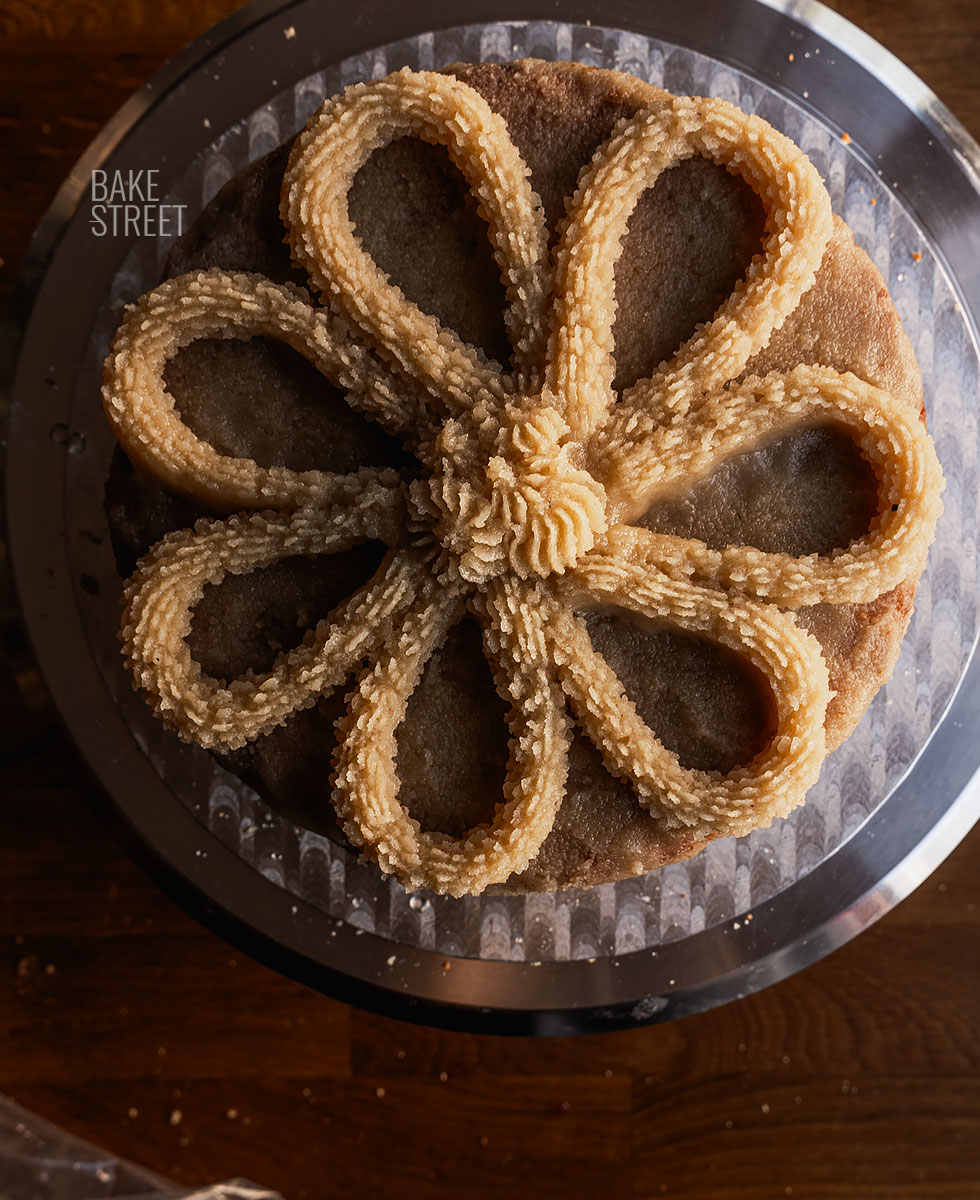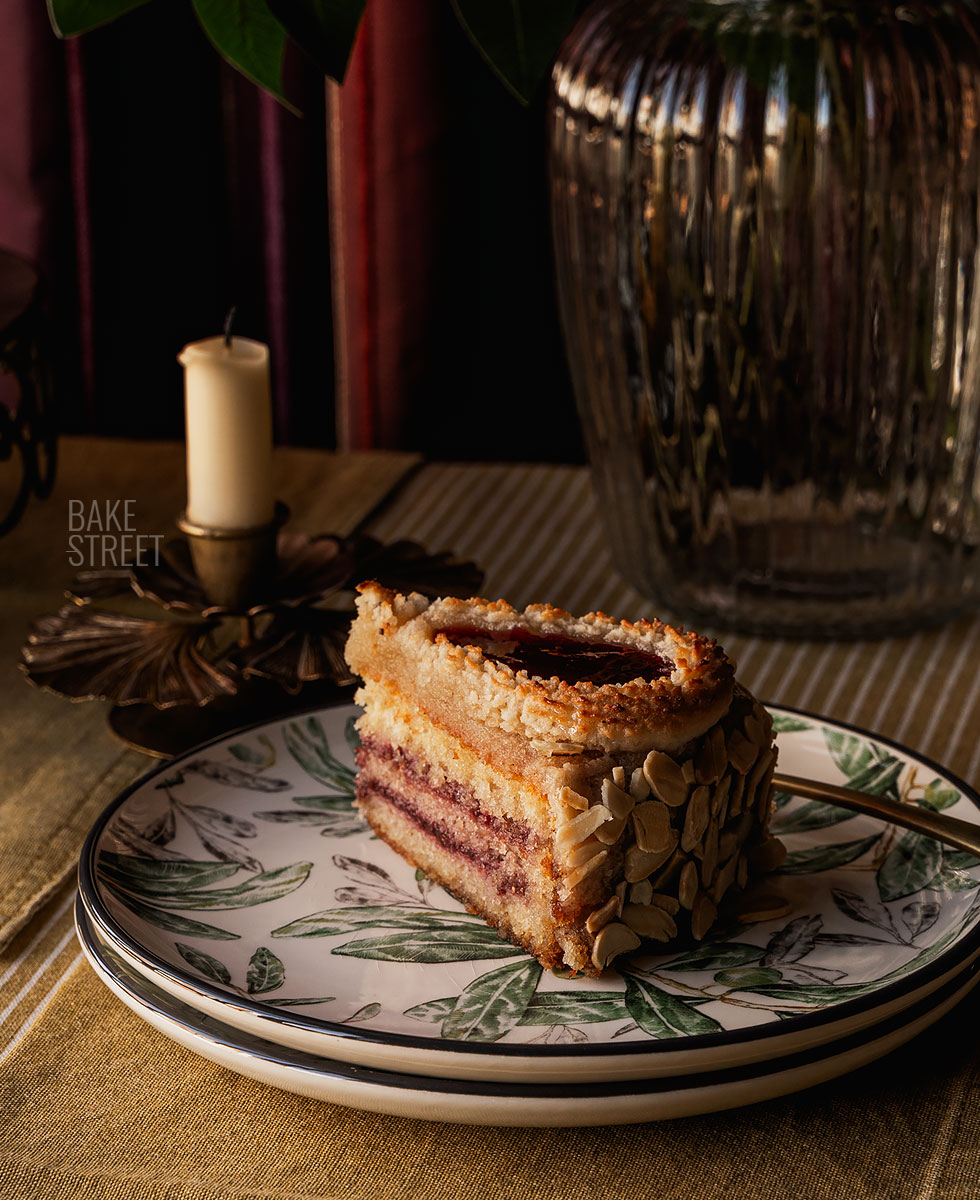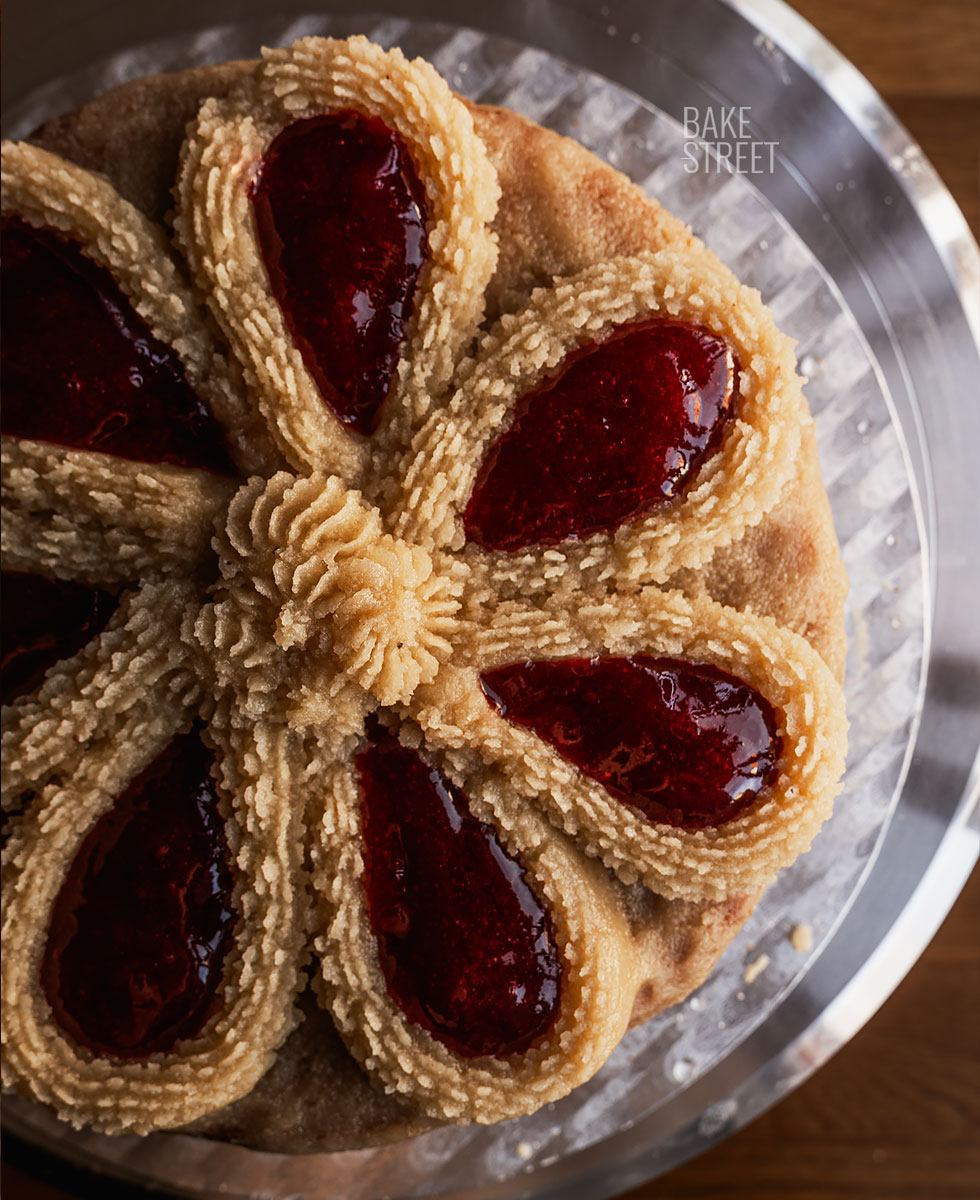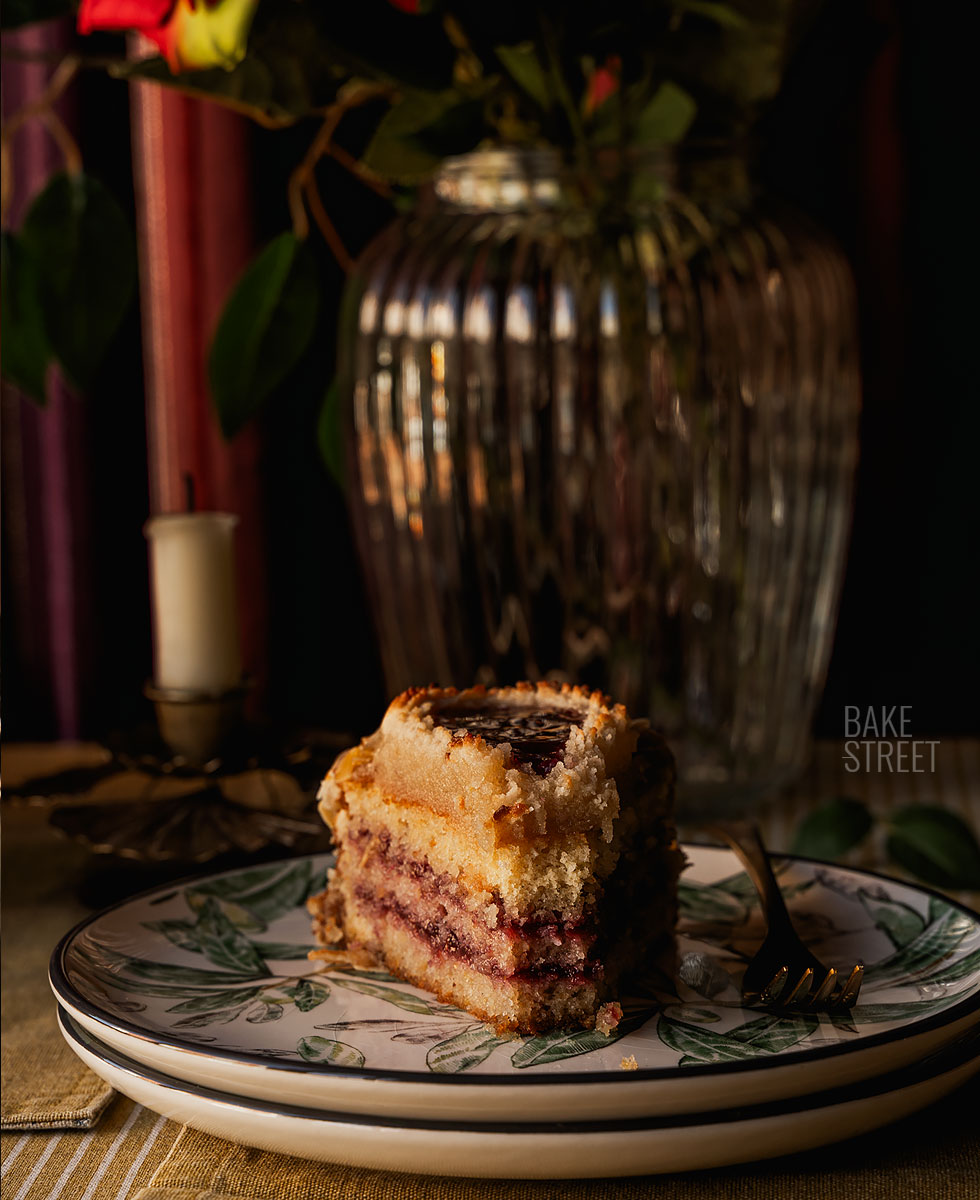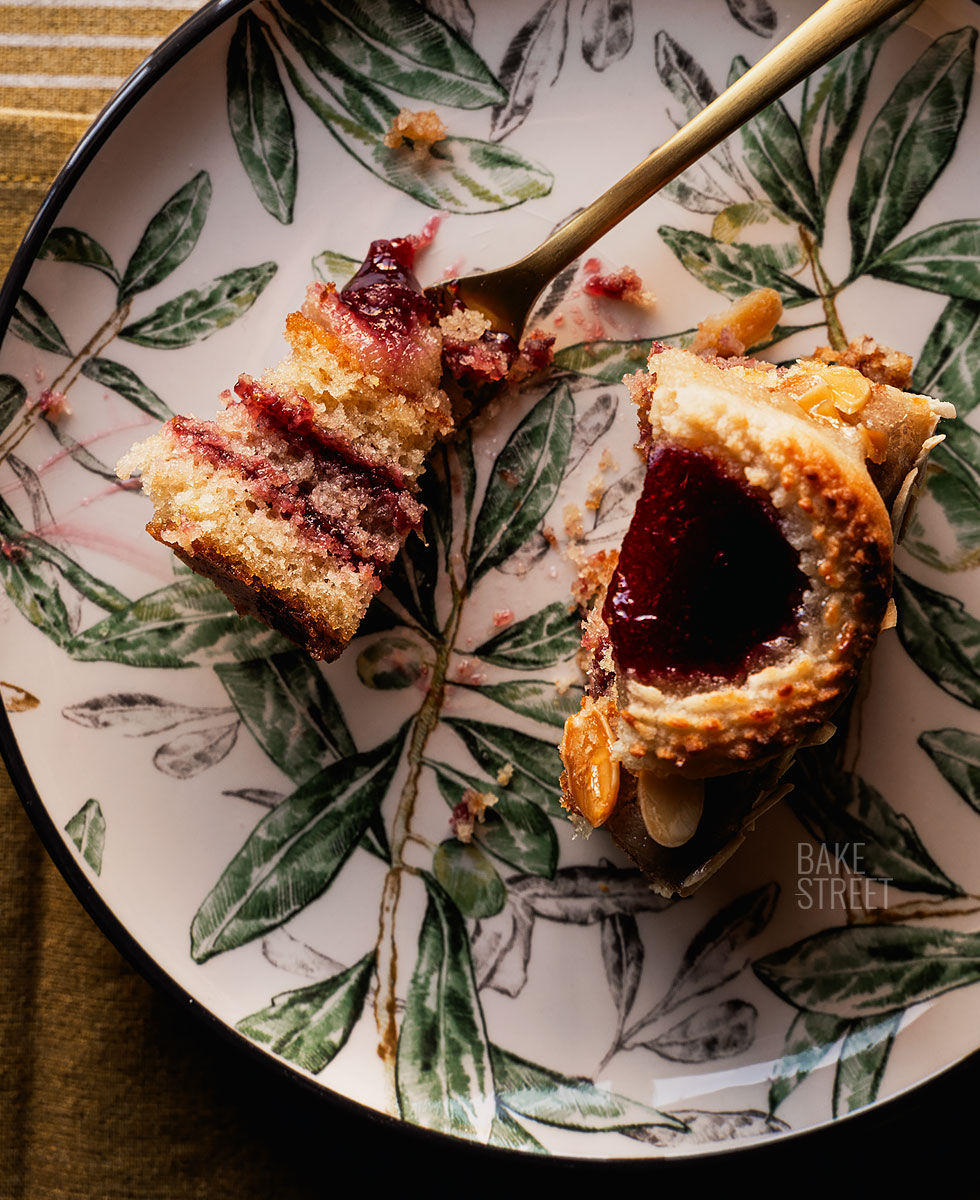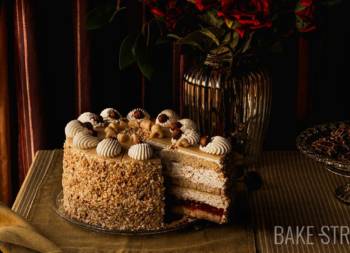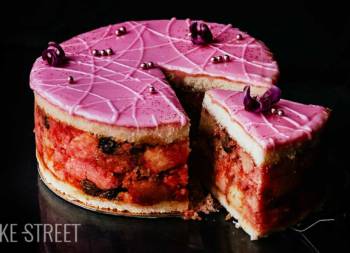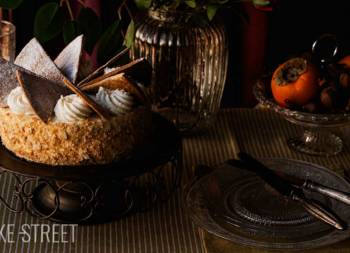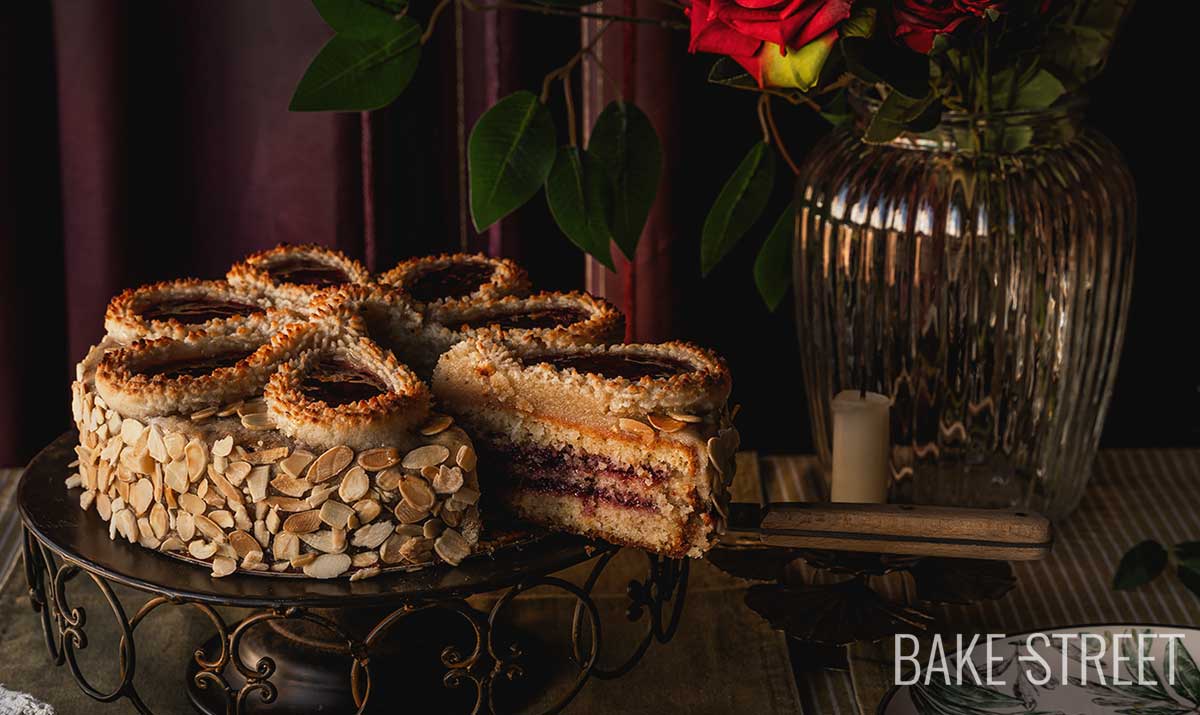
Milanese macaroon cake – Mailänder MakronenTorte
For some time now I have been very attracted to German pastries. Certainly, it has always fascinated me, but I must admit that lately almost everything I feel like making has German and Austrian heritage. The recipe I bring you today, Milanese macaroon cake – Mailänder MakronenTorte , may not fascinate you in terms of its presentation, in my case it did, but I am somewhat particular about these things… I find beauty in what other people see as “tacky”. But, I assure you, it is the juiciest, most delicate and exquisite bite you will ever taste.
The English translation of this cake would be Milanese macaroon cake, not macarons, it is a different elaboration despite sharing the same ingredients. But don’t worry, now I will tell you in depth.
The recipe I leave you with today is from one of the books I am most fond of.
And the reason is that it was the first baking book I was given as a gift, “The great book of baking“. The truth is, it is not a book that goes into detail in the process of elaboration of each recipe, in fact quite the opposite. The explanations are very brief and, in some cases, quite imprecise. I consider that if you don’t know how to do certain things beforehand, you will hardly achieve a good final result in the elaboration.
But something that I really like is the large number of recipes she shares, not to mention the style that, as you may already guess, is very vintage and old-fashioned. That is, for my taste, impressive. Another detail to note is that the translation from German is not quite good and many recipes have names that do not correspond to reality. Something that complicates the process when you want to find more information about a recipe or process.
The cake that I share with you is an adaptation of the recipe from this book, with some variations that I considered appropriate.
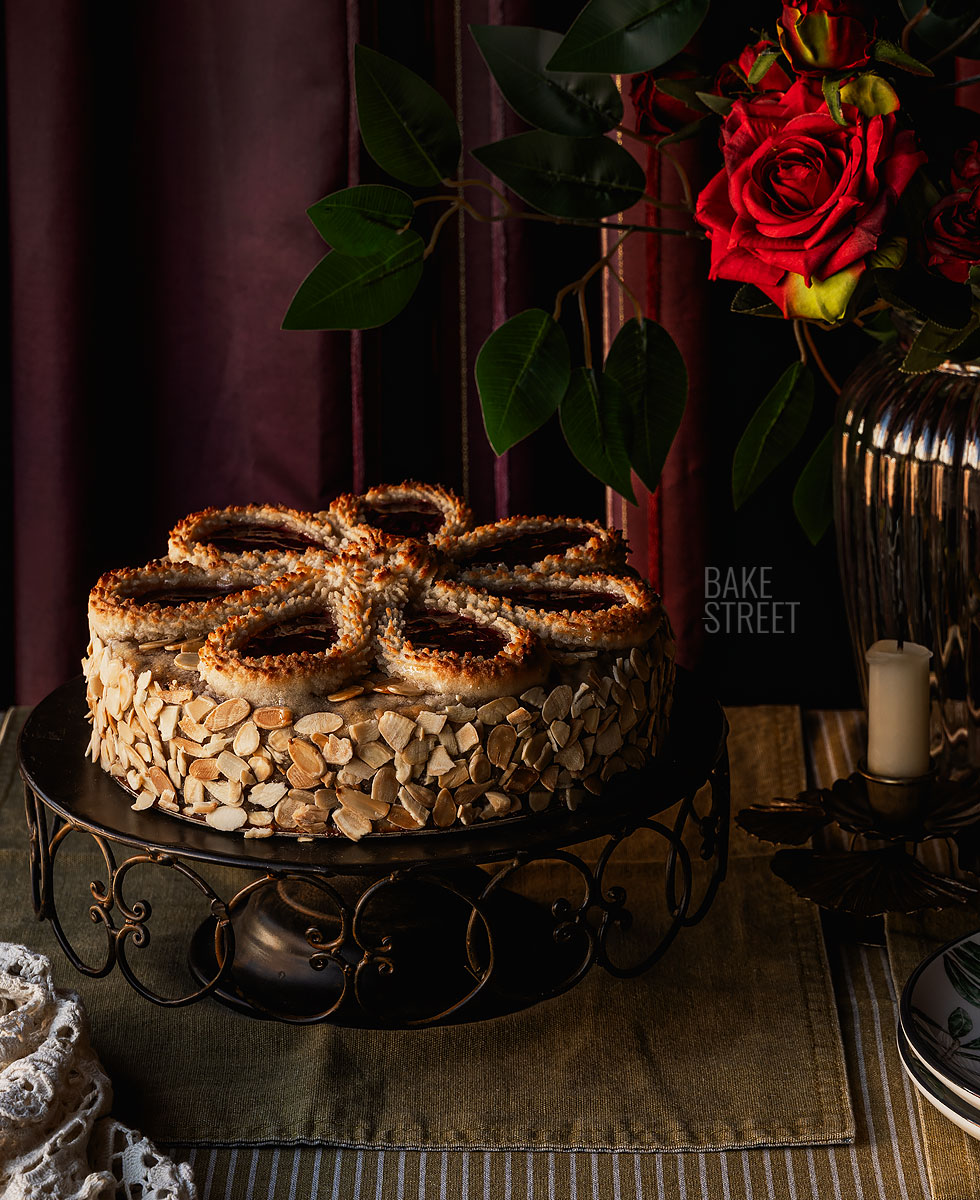
Milanese macaroon cake – Mailänder MakronenTorte origin.
The exact origin of this cake is unknown, but there is information about the appearance of two elaborations created with the same name in two German cookbooks of the nineteenth century. One of them was “Milanese Tart“, which would correspond to the preparation I leave you with today.
A cake inspired by the Viennese cake, but with the addition of a mixture of ground almonds, orange blossom water and water. It consists of layers of sponge cake interspersed with jam and decorated with a final white icing.
On the other hand, the other elaboration referred to a spongy sponge cake without the addition of marzipan or flavorings.
The recipe evolved into a cake that was made with sponge cakes interspersed with jam, in some cases even alternating layers of jam and almond cream. Later, it was decorated with macaroonsor makronen(paste made with almonds, sugar and egg white) and jam. It was then flamed so that the makronen paste would cook and acquire a nice golden color.
Once it had cooled, the side of the cake was finished with sliced or chopped almonds.
Makronen.
This sweet is very similar to the famous French macaroons, different from the traditional macarons. As I mentioned above, both sweets share the same ingredients, but differ in quantities and elaboration process.
Macaronsare small traditional pastries, very delicate and elegant, of French origin. They are made with egg white, ground almonds, powdered sugar and granulated sugar or syrup. Depending on the type of meringue with which they are made; French or Italian meringue.
Macaroons, also called macaroons, are denser pastries made with almond and egg white or with an almond paste (raw marzipan). Usually the egg white is whipped into a stiff batter along with chopped or ground nuts. The most common is almonds, although variants with other nuts and even coconut can also be found.
In both cases, the final product is baked.
On the other hand, we have the makronen. This sweet is made with a mixture of sugar, egg white and nuts; ground almonds, walnuts, hazelnuts, pistachios, coconut or other oilseeds. These ingredients can be replaced by a raw marzipan dough, which is then mixed with the rest of the ingredients to obtain the same final result.
The origin of Makronen can be traced back to the further development of recipes that originated in the Middle East and influenced European cuisine during the Arab expansion from the 9th century onwards.
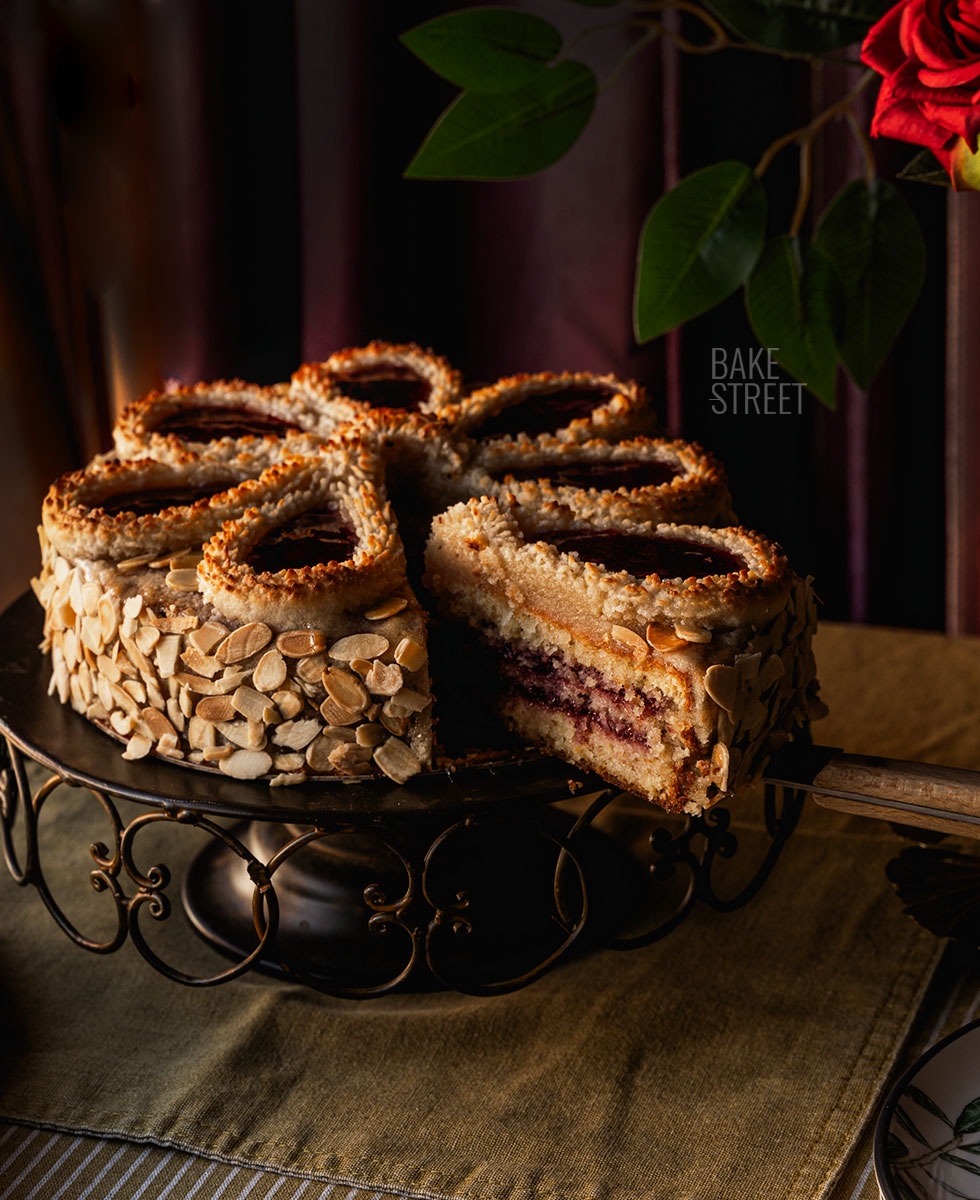
Origin of the word makronen.
The German word makronen has its origin in the French “macaron”. However, it is important to note that the French word is not identical to the German word, as it refers to a specific type of almond macaroon, known as “Macaron”.
The term has its roots in the Greek word μακαρία (makaria), which describes a flour porridge traditionally consumed at funerals, and later in “Makarona” or “Melomakarona” as a Christmas cookie. On the other hand, “Makaronia” refers to pasta, especially noodles.
In the Italian language, the term has been known at least since the appearance of the word “maccarruni” around 1279 in Sicily, an area where Greek was also spoken. Today, “maccheroni” refers to various types of durum wheat pasta. A possible relationship with the word “maccare“, meaning “flattened”, is also suggested.
Makronen evolution.
Makronen has its roots in Arabic cuisine, where ground almonds were mixed with sugar and rose water. Nut-based sweets such as fālūdhaj and lausinaj, cakes with sweet almond cream inside, were common in this region.
This sweet was inspired by the Sassanid shas of Persia, who served a similar almond dessert to celebrate the Zoroastrian New Year, Persian new year (Nowruz). With Arab expansion, these recipes reached Sicily and the part of Spain under Arab rule from the 9th century, influencing European cuisine.
The first mentions of “maccarruni” in Sicilian dialect or “maccherone” in Italian refer to a sweet pasta dish. Around 1350, Boccaccio mentioned “Maccherone” in his collection of short novels “Decameron” as a type of gnocchi eaten with butter and cheese. However, this recipe also underwent changes. In a 15th century cookbook, Sicilian maccherones were made with white flour, egg whites and rose water, and were eaten with sugar, butter and grated cheese.
In Rabelais’ “Gargantua and Pantagruel” cycle of novels, macaroni is also mentioned as a dessert in a list of fantastic desserts. Somewhat later, macaroni also appeared in the English language, and the spelling ending in “-oon” suggests that the word was borrowed from French. Giving rise to the word “macaroon“.
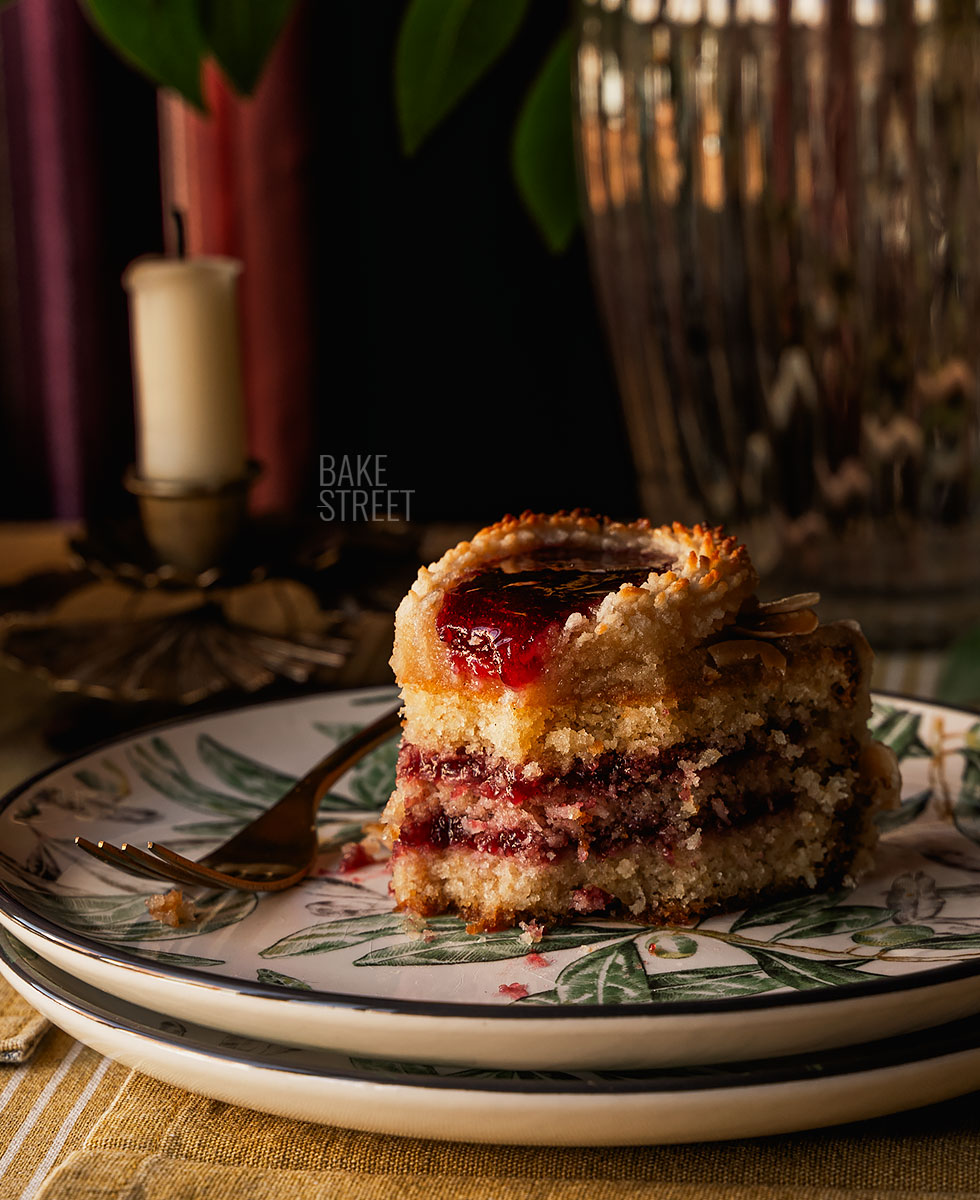
The origin of macaroons dates back to an 8th century French monastery in Cormery.
During the French Revolution, Benedictine nuns Sister Marguerite and Sister Marie-Elisabeth arrived in Nancy where they made their living baking and selling macaroons. In fact they were known as the “Macaroon Sisters“. Subsequently, the Jews adopted this recipe because of its lack of flour and yeast, which allowed its consumption during the eight days of Passover.
Macaroon recipes have been recorded in recipe books since at least 1725, using egg whites and almond paste. Over time, coconut was incorporated into the ground almonds and, in some recipes, replaced it. Occasionally, potato starch was added for consistency.
The earliest known recipe comes from a handwritten cookbook that Martha Washington’s family.
In North America and probably written in the early 17th century. This recipe used almonds, rose water, sugar, egg white and musk. These ingredients further demonstrate the connection to the original Arabic recipe.
The first recipe that resembles the modern recipe and dispenses with the use of rose water and musk is found in French chef François-Pierre de La Varenne’s 1652 collection of recipes. In the 17th century, specific regional variants of this recipe were developed in France, often made and sold in convents.
In the Italian of the time, “maccherone” referred only to pasta; pastries made in a similar manner were known as “amaretti” in Lombardy or “marzapanetti” in the region around Siena.
Coconut production.
The increasing importation of coconuts through Europe and the United States in the 19th century led to the substitution of ground almonds for coconut, especially in the United States. The first recipes appeared in the United States around 1830, and in the second half of the 19th century, recipes for coconut macaroons were found mainly in Jewish cookbooks.
Since then, coconut macaroons have often been prepared for Passover Seder night in American Jewish cuisine.
Parallel to the development of coconut macaroons, macarons were created in France, initially known as le macaron parisien or le macaron Gerbet in honor of the first pastry chef who made this sweet.
Here are several posts where I share with you how to make perfect macarons.
Makronen are a traditional Christmas cookie in Germany. Its production is documented at least since the 16th century, although it is considered likely that its origin comes from Italy. An evolution that has adapted to the culture and customs of the country.
The term “macaron” has existed in the French language since then, and in 1604, a cookbook published in Liège also mentions macarons. This pastry has been known in Germany since the 17th century.
Recipe Milanese macaroon cake - Mailänder MakronenTorte
SPONGE CAKE:
- 6 large eggs, whites and yolks separated
- 180 g sugar, separated in two equal parts (90 g + 90 g)
- 120 g cake flour
- 30 g cornstarch
- 60 g unsalted butter, room temperature
- 4 g baking powder
- 150 g ground roasted hazelnut
- 2 tsp natural vanilla extract
- one lemon zest
- pinch of salt
SYRUP:
- 150 water
- 150 sugar
- 10 g rum
FILLING:
- 350-400 g raspberry jam
MARZIPAN CREAM:
- 300 g ground almonds
- 200 g icing sugar
- 100 g egg white
- 15 g water
- 4-5 drops of almond extract (optional)
MARZIPAN CREAM COATING:
- 190 g marzipan cream
- 15 g water
MARZIPAN CREAM DECORATION (PIPING):
- 245 g marzipan cream
- 12 g water
- 130 g raspberry jam, strained (without seeds)
SIDE DECORATION:
- apricot jam or pectin syrup (recipe in this post)
- 75 g sliced almonds, toasted
MATERIAL WE WILL NEED AND SHOWN IN THE VIDEO:
- KitchenAid stand mixer*
- crystal bowl KitchenAid*
- push pan 20 cm diameter
- cake cutter
- rotating cake stand
- silicone spatula and pastry spatula
- whisk
- digital kitchen scale
- pastry brush
- cooling rack
- pastry bag + noozle Wilton 6B
- linen tablecloth from Laura Ashley*
- snap from Laura Ashley*
*You have a 5% discount on the website Claudia&Julia using this code BAKESTREET. Delivers throughout Europe.
Instructions
FIRST DAY
Prepare sponge cake.
- In the bowl of the KitchenAid, add the egg yolks and 90 g of sugar. Whisk at medium-high speed until a whitish color and a creamy texture is achieved, you will notice that it increases in volume.
- Add the butter and whisk again until a homogeneous mixture is obtained.
- Begin to incorporate the flour, little by little. We will integrate while mixing at speed 1.
- Add baking powder together with salt and mix.
- Finally, add cornstarch. We will do it in the same way, little by little and mixing at the same time.
- Once everything is integrated, set aside.
Whip meringue.
- In another bowl, add the egg whites and begin to whip. Once it begins to foam, add the sugar (the remaining 90 g).
- Whip with the whisk at medium-high speed until the meringue is firm, a little more soft peaks, but not dry. In other words, do not over whip the meringue until it is very stiff.
Add the meringue to the egg yolk mixture.
- Start incorporating the meringue, little by little, into the egg yolk mixture.
- Add a little, mix with a spatula until completely integrated and continue adding more. The first part of meringue will help us to smooth the mixture. As we add more, the mixture will become smoother and lighter.
- Finally, incorporate the ground almonds along with lemon zest and integrate with smooth and enveloping movements.
Pour the batter in the mold and bake.
- Preheat the oven to 355ºF/180ºC, with heat up and down.
- Grease and line a 20 cm diameter mold. In my case it is a springform pan, I line the sides with baking paper (I have the feeling that this way the cake rises more and better) and the base.
- Pour the mixture into the mold and tap gently to settle the mixture.
- Bake for 38-40 minutes.
- Remove from the oven, let stand for 5 minutes in the pan and unmold.
- Place on a cooling rack, upside down to allow the dome to smooth out as much as possible, and let cool completely.
- Wrap the cake in plastic wrap and refrigerate until the next day.
- NOTE: Refrigerating the cake makes the cutting process much easier.
SECOND DAY
Prepare rum syrup.
- Add the water and sugar to a saucepan. Place over medium heat and bring to a boil. The sugar should be completely dissolved.
- Once it comes to a boil, reduce to medium heat, cook for 5 minutes and turn off the heat.
- Stir in the rum, mix to homogenize and let it cool completely.
Prepare marzipan cream.
- In a large bowl, add ground almonds and icing sugar. Mix with the help of a whisk to combine both ingredients.
- Add the egg white and mix until homogenized.
- Pour the water together with the almond extract and mix again to homogenize.
- Cover with plastic wrap and let stand at room temperature while you prepare the cake.
Cut the sponge cake.
- With the help of a cake cutter, cut the cake into three equal parts.
- In my case, I also removed a small part of the dome to make the top as straight as possible.
- Set aside wrapped in plastic wrap to prevent it from drying out.
Assemble the cake.
- Place on a rotating cake stand an anti-slip and, on top of it, a cake base. Spread a small amount of marzipan cream and place the first sponge cake on it.
- Put a small amount of marzipan cream in a piping bag. The purpose is to pipe a small ribbon on the edge of the sponge cake to contain the jam filling.
- To facilitate the piping central jam filling, I recommend that you put the jam in a piping bag. You need about 350-400 g of jam to fill the cake.
- Brush generously with the syrup.
- Pipe a thin ribbon on the outside of the cake.
- Fill the inside of the marzipan circle with the raspberry jam. Smooth the surface with a pastry spatula.
- Place the second disc of sponge cake and brush generously with the syrup.
- Repeat the same process to fill, pipe the marzipan cream and fill the inside with jam.
- Finally, place the last sponge cake and brush generously with the syrup.
Prepare marzipan coating.
- Mix the marzipan cream with the specified amount of water to a uniform and homogeneous consistency. You need it to be easy to spread, but not too fluid so that it adheres to the cake.
Cover the outside of the cake with the marzipan cream coating.
- Cover the top and sides with the marzipan coating.
- Make sure the finish is as straight and smooth as possible.
Prepare the marzipan cream for the top decoration.
- Mix the marzipan cream with the specified amount of water to a uniform and homogeneous consistency. You need it to be more consistent than the topping so that it will hold its shape after piping.
Decorate the top of the cake.
- Pipe in the upper part 7-8 tears with the marzipan cream.
- In the central part, pipe small quantities simulating small flowers.
- Put the raspberry jam, strained without seeds, in a piping bag.
- Fill each teardrop with the jam.
- Refrigerate the cake for 1 hour. This step helps the marzipan to keep its shape better for later baking.

Bake the cake to golden brown the marzipan.
- Preheat the oven to 482ºF/250ºC, heat up and down.
- Place the cake, with the base disk, on a tray lined with baking paper.
- Bake the cake, placed on the second rack starting from the bottom, for 10 minutes.
- Remove and let cool completely on a wire rack.
- NOTE: I recommend you to be attentive during the whole process of this second baking because, depending on each oven, the cake may take more or less time to acquire a nice golden color.
Finish decorating the cake.
- Brush the sides with pectin syrup (recipe in this post) or warm apricot jam.
- Cover the sides of the cake with toasted flaked almonds.
- If you wish, you can decorate the gaps between the teardrops with flaked almonds.
- Serve.

Notes
- To line the baking pan, you can grease the base and sides with butter to help the baking paper stick to it. The butter can be replaced with release spray.
- The sponge cake is tender, but I recommend brushing it with syrup. The final result is very moist, as if it were "drunk", leaving a sensational texture. In my case I used almost all the syrup.
- I recommend using toasted almonds, you can toast them at home, to add more flavor and aroma to the final result. There is a big difference in this step.
- For the filling I used the raspberry jam without straining it, that is, with its seeds. But for the top decoration, I do recommend that you strain it to remove the pips. The end result is much cleaner and more attractive. After cooking, the texture is very similar to a raspberry cream or jelly.

- The marzipan cream ribbon on the sides is optional, but I recommend that you do it because it helps contain the jam filling without the risk of it coming out of the sides.
- As you may have noticed, a marzipan base cream is prepared from which we add more or less water for different uses. The coating needs to be softer to be able to spread it, while the decoration needs to be a little firmer (but less than the base) so that it keeps its shape after piping.
- The amount of water in the marzipan cream can vary depending on the quality of the almonds used. The fresher it is, the less water it will need. Conversely, the drier it is, the more water it will require.

- You won't have any marzipan cream left over.
- For the side of the cake you can use cake glaze or apricot jam, whatever you prefer.
- Once the cake is finished and assembled, it can be kept for 2 days at room temperature or refrigerated for 10 days. It holds very well over time and remains very tender and moist.

This cake is completely spectacular for me, in every way. Flavor, aroma, texture, moistness... Even presentation, despite the fact that at home I was told that the decoration looked like churros. You already know that I have a certain admiration for everything that is out of the ordinary. You have to try this Mailänder MakronenTorte or Milanese macaroon cake.
It is absolutely perfect to enjoy at any time of the day. As a dessert, to accompany a tea or coffee... It works well for me at any time.
By the way, I remind you that you can watch all my videos on my YouTube channel. If you subscribe and turn on the little bell, I will be eternally grateful!
I wish you a wonderful Sunday afternoon!
Lots of love,
Eva
Sourcs: Wiki DE, Wiki, BMel, Slate, Cor Ca, Etym Online, The Nibble
This post contains affiliated links.
